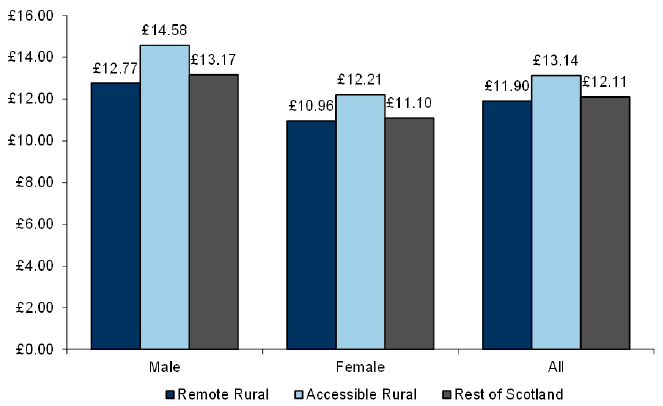Understanding the Scottish rural economy: research paper
This report outlines the Scottish Government's understanding of the Scottish rural economy and presents economic and social data.
Earnings and the Gender Pay Gap
Earnings also vary by people's locality, and also by gender. People living in Accessible rural areas have the highest average incomes in Scotland, whereas people living in remote areas have the lowest average incomes. This is likely to be at least partly because of higher income commuters who work in larger urban areas, rather than through an inherently higher level of productivity found in Accessible Rural Scotland. The low incomes of people in Remote Rural Scotland can be compounded by additional costs including more expensive food, fuel and other goods, as shown in work on the Minimum Income Standard for Remote Rural Scotland, [9] which suggests to support equivalent standards of living that incomes need to be between a tenth and third higher in remote areas. Median hourly rates of pay are shown below:
Chart 16: Residence based median hourly rates of pay [10] by geographic area and gender, 2016

Source: Annual Survey of Hours and Earnings, 2016 (Using the Scottish Government Urban Rural Classification 2013-2014)
Chart 16 shows the median hourly wage rate for all male and female employees residing in each of the geographical areas. In all areas of Scotland the median wage for males is higher than that for females. The median wage of those who reside in Accessible Rural areas is highest for both males and females. The differences in median hourly rates of pay between the different areas are greater for males than females. The largest difference is between males who reside in Accessible Rural and Remote Rural areas (£1.81 higher per hour in Accessible Rural areas).
Table 7: Residence based median gross annual pay for full-time employees [11] by geographic area
| Remote Rural | Accessible Rural | Rest of Scotland | |
|---|---|---|---|
| Male | £29,017 | £32,098 | £29,765 |
| Female | £23,941 | £27,523 | £24,799 |
| All | £27,074 | £30,452 | £27,715 |
Source: Annual Survey of Hours and Earnings, 2016 (Using Scottish Government Urban Rural Classification 2013-2014)
Table 7 shows that the median gross annual pay ( i.e. before taxation and other deductions) for all full-time employees is highest for people living in Accessible Rural areas. This is followed by people living in the rest of Scotland and then finally those residing in Remote Rural areas. The disparity in median pay between rural areas and the rest of Scotland is greater for females than for males.
Table 8: Gender Pay Gap by geographic area
| Gross Gender Pay Gap by geographic area | Remote Rural | Accessible Rural | Rest of Scotland |
|---|---|---|---|
| Annual median wage difference | £5,076 | £4,575 | £4,966 |
| Gender Pay Gap | 17% | 14% | 17% |
Source: Annual Survey of Hours and Earnings, 2016, (Using Scottish Government Urban Rural Classification 2013-2014)
For median wages, overall the gender pay gap varies by geography, it is at 14% in Accessible Rural Scotland, and at 17% in both Remote Rural Scotland and the rest of Scotland. It is highest in absolute terms in Remote Rural Scotland, at £5,076, and lowest in Accessible Rural Scotland at £4,575, which also has the highest average incomes. Women working in Remote Rural Scotland have the lowest overall annual median income at £23,941. It is not clear what drives this as we do not know whether it is the type of jobs causing the pay gap or other factors. This may be worth further study. Here, a survey could examine the types and level of jobs women pursue. Additionally, research into gender attitudes and data on access to nurseries and informal care would be helpful to examine the gender pay gap.
Contact
There is a problem
Thanks for your feedback